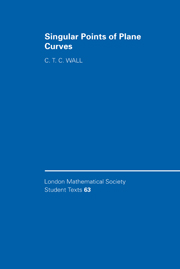Book contents
- Frontmatter
- Contents
- Preface
- 1 Preliminaries
- 2 Puiseux' Theorem
- 3 Resolutions
- 4 Contact of two branches
- 5 Topology of the singularity link
- 6 The Milnor fibration
- 7 Projective curves and their duals
- 8 Combinatorics on a resolution tree
- 9 Decomposition of the link complement and the Milnor fibre
- 10 The monodromy and the Seifert form
- 11 Ideals and clusters
- References
- Index
9 - Decomposition of the link complement and the Milnor fibre
Published online by Cambridge University Press: 04 December 2009
- Frontmatter
- Contents
- Preface
- 1 Preliminaries
- 2 Puiseux' Theorem
- 3 Resolutions
- 4 Contact of two branches
- 5 Topology of the singularity link
- 6 The Milnor fibration
- 7 Projective curves and their duals
- 8 Combinatorics on a resolution tree
- 9 Decomposition of the link complement and the Milnor fibre
- 10 The monodromy and the Seifert form
- 11 Ideals and clusters
- References
- Index
Summary
In this chapter we begin the deeper study of the topology attached to the Milnor fibration. One key problem is to obtain an understanding of the monodromy. A major tool for this is a canonical decomposition of the Milnor fibre. Because the decomposition is intrinsic, it gives a better picture of the topology than we attained in Chapter 5, particularly when the curve has several branches. We discuss the decomposition theorems in this chapter, leaving the application to monodromy to Chapter 10. Although we present an introductory account of these matters, we will necessarily assume a higher level of mathematical sophistication than was the case in earlier chapters.
We may use the carousel of Section 5.3 or the resolution tree of Section 3.6 to obtain a decomposition. We will see directly that the same is obtained from each approach, but this fact is underpinned by major theorems of great generality. Although we do not need these results, we describe them to set our discussions in a wider context. We thus begin with a section stating the general decomposition theorems in 2- and 3-dimensional topology which underlie the constructions.
We now explain what we mean by ‘decomposition’. A decomposition of a connected manifold M is effected by cutting along submanifolds of codimension 1. If T is a connected submanifold which separates M into two pieces, then if M1,M2 are the closures of the two complementary regions, the result of cutting is defined to be the disjoint union of M1 and M2.
- Type
- Chapter
- Information
- Singular Points of Plane Curves , pp. 219 - 264Publisher: Cambridge University PressPrint publication year: 2004



